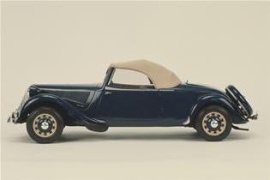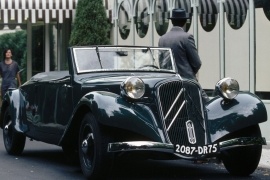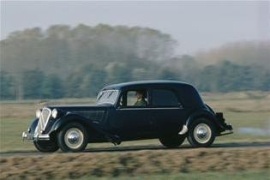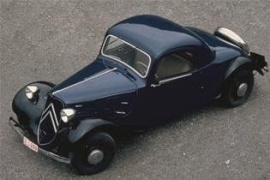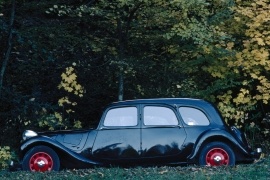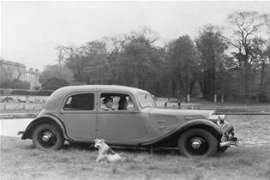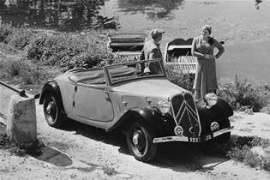CITROEN Traction Models/Series Timeline, Specifications & Photos
First production year: 1934
Engines: Gasoline
This is one of the rarest versions of the Citroen Traction Avant. Its history began shortly before WWII tore the world apart: the TA 15/6 Cabriolet.
Even though some people were concerned about a war with Nazi Germany, others were just relaxed and hopeful that it won't happen. Thus, they continued with their lavish lives and looked for special vehicles. Therefore, when the Michelin family ordered a particular car from Citroen, the French automaker felt obliged to answer the request. After all, Michelin was the one that saved the carmaker before the launch of the Traction Avant in 1935. Nevertheless, the tire manufacturer still owned a big chunk of shares in Citroen.
Based on the same platform as the regular Citroen TA convertible from 1935, the TA 15 featured a modified bodywork. First, the carmaker added a set of tumble seats, squeezed between the cabin and the trunk, accessible from the outside. Next, these seats were covered by a lid that transformed into the backseat of that folding bench. Finally, behind them, Citroen installed the spare wheel on the trunk's lid.
Under the hood, the carmaker installed the latest iteration of the inline-six powerplant with a 2.9-liter displacement. That turned to the right instead of the left as on the previous units. Power went to the front wheels via a front-mounted four-speed manual.
Immediately, the automaker received other special requests for 15/6 convertibles. It is unclear if three or four bodyworks were built in 1939, but only one was completed: the one for Michelin. After the war, two of them were also finalized, while the fourth one (if it ever existed) had disappeared.
André-Gustave Citroën was a revolutionary French engineer and left a precious legacy to the automotive industry: the Traction Avant, or TA for short.
The French automaker already had a vast experience in the car industry. He founded his own brand in 1919 and gathered as much information as he could from other carmakers. That led to the development of the Traction Avant. While it was not the first front-wheel drive vehicle, and neither was the first built on a monocoque bodywork (when everyone else was building cars on body-on-frame solutions), it was the most successful. So much that, even if it was almost bankrupt when Cit Citroën roen launched the TA in 1934, the car paid the automaker's debts in just two years. Unfortunately, André Citroën died in 1935 and didn't have time to enjoy the full success of its last brainchild, the Traction Avant.
Even after the company's founder passed away, the automaker's leaders and the engineering team felt obliged to carry on the legacy left behind. Thus, in 1938, Citroën launched the open-top version of the Traction Avant. That was a very tricky situation since the engineers had to return to the chassis solution instead of the monocoque one due to the lack of a roof. Unlike the regular four-door version of the car, the Cabriolet featured a pair of rear-hinged doors and a canvas roof. In addition, the windshield could have been folded down for a complete open-air experience.
The cabin was fitted with a bench for two people, while the area in the back was used to store the canvas roof. Citroën already understood that this was a car built for pleasure, not utility. That's why it didn't bother making it a four-passenger vehicle.
Citroën developed the front-wheel drive system in a different way, with the engine placed behind the gearbox. That solution allowed the TA to sport a very long wheelbase, with the front axle pushed forward. But since the carmaker tried to offer a fuel-efficient vehicle, it only installed small, inline-four engines under the hood. Still, thanks to the low weight of the vehicle, it was very nimble.
Citroen introduced a more powerful version of the Traction Avant in 1938, namely the 15/6, which was a more appropriate engine for this French Executive sedan.
During WWII, the production numbers for this new version were small. Still, after 1945 the French automaker thrived back again, and the 15/6 was already a prized vehicle. Apart from the vast majority of people who could barely make a living, there was also a new category of customers who asked for more performance.
Designed in the early '30s, the Traction Avant had a unique design. Since it was a unibody construction, without a separate chassis, it sported a lower ground clearance and a sleeker look. Yet, the front of the car featured the same narrow engine compartment flanked by the two ample wheel arches. The gull-wing style opening hood was continued by a flat, steep windshield. At the same time, on the profile, the four-door bodywork was elegant and subtle, with a tall greenhouse and an almost vertical rear end where the trunk and the spare wheel were kept. Its front rear-hinged doors helped the driver and the side passenger to quickly step down and open the rear doors for those seated in the back.
The interior was not very different than the mundane Traction Avant 7CV. Yet, the automaker considered using more expensive materials, so the seats were no longer covered in fabric but leather. Thanks to the car's technical solution, the gear stick was mounted next to the steering wheel.
The Traction Avant was the first mass-produced front-wheel drive vehicle in the world. Moreover, its unibody construction and the independent suspension in all corners were other technological breakthroughs. In addition, the 15/6 variant (or 15 G) was powered by a 2.9-liter inline-six (hence the /6), while the 15 was referred to the French tax system: 15 fiscal horsepower (albeit they were actually 16).
When the French automaker introduced the Traction Avant in 1934, the world was stunned since the car offered quirky features for those times, and that included the unibody construction and the front-wheel drive.
But the small-sized TA (Traction Avant) was not enough for many customers. Thus, André Lefèbvre and Flaminio Bertoni went back to the drawing board and penned the larger 11 L version. In addition, they made it also as a faux-cabriolet. This type of bodywork was often mistaken for a Coupe Cabriolet, although Citroën didn't have that yet. Only Peugeot managed to create the 402 Eclipse with a retractable hard top. Even though the Faux Cabriolet (fake cabriolet) was produced in just 15 units.
The car's look was indulged by a new, revised front fascia that sported a black grille with chromed surrounding adorned by the "double-chevron" trim. Strangely, the headlights were mounted on stacks supported by the engine compartment, not by the fenders. But the most intriguing part of the car was its profile. The greenhouse was short, with two doors, and abruptly sloped down behind the cabin. Finally, at the back, the automaker installed the spare wheel onto the trunk's lid.
Inside, Citroën installed two seats on the flat floor. Since there was no transmission tunnel to cross the cabin, the legroom was not a problem. In addition, the gear lever was mounted on the dashboard, so there was a free passage between the left and right doors. Also, Citroen placed the speedometer and other gauges next to the gear stick in the midsection of the dash.
Under the hood, the revised version of the TA featured a two-liter gasoline engine paired with a three-speed manual gearbox that sent its power, obviously, to the front wheels.
Citroen introduced the Traction Avant (Front-wheel drive) on the market in 1934, a car that managed not only to save the French automaker but also remained in production until 1956.
Andre Citroen tried to get the most advanced technologies on the market and put them into a mass-produced vehicle. While the Traction Avant, or TA for short, was not the first front-wheel driven vehicle nor the first with unibody construction, it combined more elements that made it a successful vehicle, although Andre Citroen didn't enjoy that success since he died in 1935.
The German carmaker DKW already proved in 1928 that the cars didn't need a chassis, and the Americans from Cord produced their first front-wheel driven vehicle, but Citroen combined these two elements. In addition, it put them into a vehicle that still resembled the same shape as the cars from that era, with long and curved wheel fenders and a narrower engine compartment. Citroen also installed the gearbox in front of the engine. That led to a very long wheelbase for a car of that size. The tall greenhouse and the four doors allowed an easy ingress and egress. At the back, the sloped bodywork hosted the trunk.
Inside, Citroen went even further with the design and created ample room for both front and rear passengers. Moreover, since there was no transmission tunnel to cross the car, the rear floor was flat. It was a true five-passenger vehicle. At the front, the carmaker installed an in-dash gear stick, which also cleared the floor. The speedometer was in the middle of the dashboard and also incorporated the odometer, the temperature, and a few other gauges, inside the dial.
But the underpinnings of this vehicle was the one that brought its success. The front wheel independent suspension, the rear Panhard-rod type of drivetrain, and the hydraulic brakes led to a pleasant drive for its customers.
With the Citroen Traction Avant, the French automaker broke all the rules from the technical books and thus produced the most advanced car of its era, and the model lasted for more than two decades on the market. It even survived WWII.
When Andre Lefebvre and Flamino Bertoni started the work on the car, they didn't even dream about how successful the TA would become. TA came from the Traction Avant, which meant front-wheel traction (or drive) in French. Because yes, the TA was a front-wheel driven vehicle built in a time when most of the cars were with rear-wheel drive systems. Moreover, the car was fitted with independent suspension in all corners and a unibody bodywork, giving up on the body-on-frame construction system.
The long hood engine compartment flanked by arched fenders that supported the headlights was usual for those times. But the car's low ground clearance was unusual, and that was made possible thanks to the lack of a ladder chassis. TA's tall greenhouse was a promise of enough headroom, and to ease the ingress and egress, the automaker hinged both doors on the B-pillars. In the back, the almost vertical rear windscreen and the sloped-down trunk lid looked stylish for those times.
Inside, Citroen installed two seats at the front and a bench in the rear. The only way to access the trunk was from the car's interior. On the dashboard, the automaker installed the instrument panel in front of the driver and, next to the steering wheel, it placed the gear-stick.
Despite the long hood, the automaker installed an inline-four there. But that extra space was needed for the gearbox, which was mounted between the engine and the radiator. The 7 designation came from the fiscal power, a system used by the French administration.
Based on the same platform as the Citroen TA 7B, the S version featured a larger, more powerful engine.
The Citroen Traction Avant was not the first vehicle with front-wheel drive, but it was the first that combined that with a unibody bodywork. Due to that technological difference, it was 70 kg (154 lbs) lighter than a similar vehicle with a chassis. After Citroen installed bigger engines, the French carmaker changed the designation, so the 7S roadster became RPVS.
Its sleek and low height made the Citroen TA different than other cars on the market. The long hood and rakish windshield were ahead of its times. It still kept the flared fenders both front and rear and but without side pods. At the front, the rakish grille featured the big Citroen logo, with two inversed V-letters (double-chevron). To make easier access in the cabin, the carmaker installed rear-hinged doors (suicidal doors).
Inside, the car featured two individual seats for the front passengers and a rumble-seat in the back, behind the canvas-top. The latter was completely retractable and covered with a piece of fabric.
Citroen TA featured an independent front suspension with torsion bars and double A-arms. In the back, it featured a semi-independent suspension with an aluminum twisting axle, Panhard-rod, and trailing arms. It was quite an advanced system for those times. The 2.0-liter engine was paired to a 3-speed manual gearbox.
